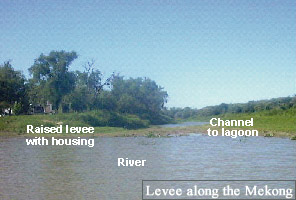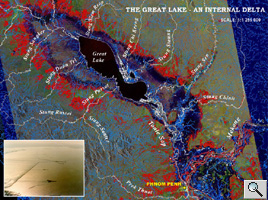The Floodplain
The floodplain consists of two main components:
• An area of floodable land that is submerged in the flood and dry in the low water season.
• A number of water bodies some of which retain water throughout the year and some of which dry out.
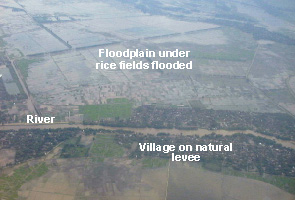 |
|
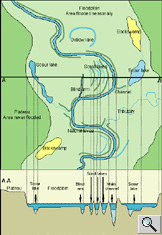 During
the floods, water rises in the channel until it reaches a level beyond
which it overflows the riverbank and begins to spread across the low-lying
floodplain on both sides of the river. This level is known as bankfull
discharge.
During
the floods, water rises in the channel until it reaches a level beyond
which it overflows the riverbank and begins to spread across the low-lying
floodplain on both sides of the river. This level is known as bankfull
discharge.
When water first crosses the bank, the speed of its current diminishes
rapidly and it deposits the coarser sediments to form a raised area known
as a levee. Levees usually flank the main channel, but may be present
on the banks of channels feeding the floodplain water bodies. Levees provide
areas that are relatively suitable for human settlement and many villages
are found on them because they are less prone to flooding. Levees are
often heightened artificially to lessen risks of flooding, and to retain
the main channels of the river water within the channel even during floods.
Overbank flows across the floodplain form localised currents that erode
the plain, building new channels and lakes. In other places eddies and
local slowing of currents deposit sediments to form areas of higher ground
and levees. Differences in altitude over the floodplain are not great
and the whole area gives an impression of being flat. Nevertheless the
few centimetres of difference between one area of plain and another can
make a great difference to flooding patterns, habitats for aquatic organisms
and vegetation types.
At any one time, the form of the floodplain results from interactions
between the channel forming process of the main river and the erosion-deposition
processes on the floodplain. Under natural conditions, these create a
ratio of water bodies, channels and floodable land that remains relatively
constant over time although individual water bodies disappear through
silting and new ones take their place. Under modified conditions, the
rate of disappearance of old bodies and appearance of new ones is greatly
influenced by the amount of silt carried by the river.
Water bodies formed from channels are usually relatively deep and, initially,
the same width as the channel from which they were formed. Water bodies
formed from surface scour are usually shallow but more extensive.
In their original state many floodplains were forested. Others were covered
with grassland that formed extensive floating mats during the floods.
Some of the grassland floodplains were used to graze cattle and were maintained
by seasonal burning. More floodplains of both types recently have been
cleared and developed for various types of agriculture. In the Mekong
basin most floodplains now serve for rice culture, with artificial separations
between fields and extensive ditching that has largely replaced the original
structure of the plain.
Habitats of the floodplain are very varied, despite the apparent flatness
of the environment. During the wet season the roots and submerged stems
of the masses of floating vegetation that grow across the plain are covered
with mats of epiphytes. Young fish and other aquatic animals feed on this
as well as find shelter among the roots. Young of other species are found
in the shallow water at the edge of the advancing flood where there is
an abundance of small animals (crustacea and insects) that serve as their
food. Adult fish use the floating vegetation or the shallow water at the
edge of the floodplain as breeding sites. They also feed on the larger
invertebrate life in the vegetation as well as on seed falling from the
flowering heads of the grass. Other aquatic organisms use the flooded
forest for similar services with the addition of the food provided by
falling fruits and seeds.
During the dry season, the different types of pool form different types
of living space depending on their size and depth. The riparian zone of
floodplain lakes is usually fringed by emergent vegetation. The shallows
are filled with floating leaved plants and the clearer areas attract rooted,
submersed aquatics.
Many pools dry out killing all the fish that have taken refuge there.
Others retain water throughout the year. Larger lagoons may retain oxygen
throughout the year but smaller lagoons may become completely devoid of
oxygen.
All these different characters attract different species of fish and other
aquatic animals accounting for the huge diversity of species.
Normally floodplains are relatively narrow following the river for much
of its course. However, in certain areas special features arise. Extra
large plains may be flooded where geographical conditions are right. In
these the river tends to form several main channels and such areas are
known as internal deltas.
In other areas, large lakes may persist - these are usually the remnants
of marine incursions or old freshwater lakes that are silting up but have
not yet become completely filled.
|
|
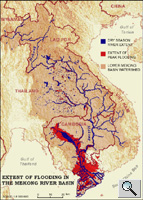 |
